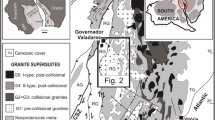Abstract
The architecture of the European Variscides has been subdivided by Kossmat (1927) into paleogeographically coherent units which are presently interpreted as former plate fragments. The Mid-German Crystalline Rise (MGCR) separates two fragments (Rhenohercynian and Saxothuringian belts) at the site of an inferred plate boundary and reequilibrated orogenic root. The commonly favoured model interprets the MGCR as the magmatic arc on Saxothuringian crust above a south-dipping subduction zone in Upper Devonian and Carboniferous times. Data from the MGCR, the kinematic evolution of the Mid-European Variscides, and first order volume balancing suggest a reinterpretation of this unit which challenges classical views on the MGCR as well as on the subdivision of Variscan architecture. The MGCR is composed of two rock groups with different tectonic identity. A Lower Carboniferous low pressure-high temperature magmatic arc association on Lower Paleozoic basement rests tectonically on a stack of medium pressuremedium temperature rocks of inferred Rhenohercynian origin. The latter were tectonically accreted to the base of the overriding plate by tectonic underplating. The entire process was controlled by oblique convergence. This led to regional partitioning of the plate kinematic vector into contractional domains (lower Rhenohercynian plate and back-arc area of the upper Saxothuringian plate), bulk heterogeneous plate margin parallel extensional domains (MGCR), and plate margin parallel wrench domains (MGCR boundaries). During this process material was continually transferred from the lower plate to the upper plate, uplifted and exhumed by net crustal extension. The concomitant removal of parts of the former arc and the entire orogenic root necessitates a reappraisal of Variscan architecture and evolution.
Similar content being viewed by others
Author information
Authors and Affiliations
Additional information
Received: 5 January 1996 / Accepted: 27 September 1996
Rights and permissions
About this article
Cite this article
Oncken, O. Transformation of a magmatic arc and an orogenic root during oblique collision and it’s consequences for the evolution of the European Variscides (Mid-German Crystalline Rise). Geol Rundsch 86, 2–20 (1997). https://doi.org/10.1007/s005310050118
Issue Date:
DOI: https://doi.org/10.1007/s005310050118




